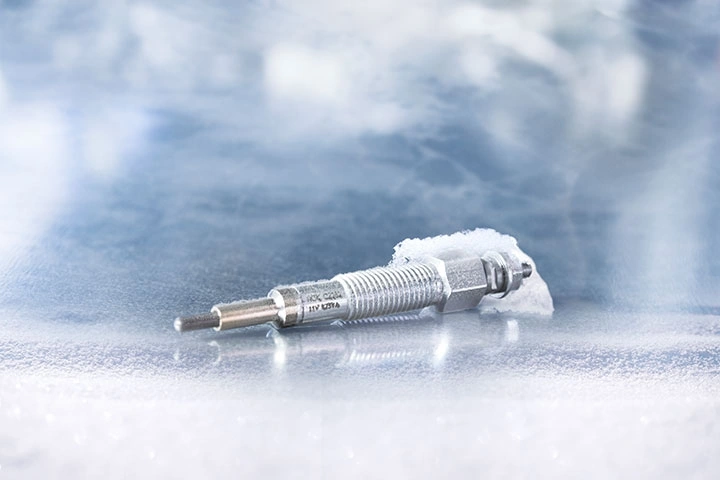For us it’s all about the engine

The conditions are ideal: in an area of 2,200 square meters, the Technical Centre has three engine test benches - two engine test benches with an asynchronous (induction) motor and two roller test benches with an integrated air blower and cold chamber, made to test extreme temperatures from -30 °C to +30 °C. “One of the extreme conditions NGK products are tested for is what we call ‘cold start validation’, performed in the cold chamber,” explains Stefan Schulte.

 Tinkering with cars
Tinkering with cars
Today’s vehicle is being tested at -30°C ambient temperature. Testing under such conditions requires special thermal underwear, a cryoprotective suit, thermal boots and gloves. “Even if the conditions sound extreme, it’s part of a standard automotive test. For us here in Ratingen, it’s everyday business to put on our cold suit”, Schulte smiles. The centre’s General Manager loves tinkering with cars. He started his career with a car mechanic apprenticeship at the age of 16, then went back to school, and after finishing his studies in mechanical engineering, joined NGK 22 years ago. Today, he takes us on a tour of the centre. “We have extensive systems for exhaust gas analysis”, he says, showing us a garage where hoses are connected to the exhaust pipes of a BMW that’s currently on the test stand. All the technologies used at the centre are specifically geared to the requirements of the automotive industry, and NGK SPARK PLUG EUROPE regularly updates the equipment so it’s state-of-the-art. A second asynchronous machine (induction motor) has just been added to an engine test bench instead of the eddy current brake previously used, making it even more powerful. Thanks to the ‘upgrade’, the output power of the motor can be fed back into the National Grid in the form of electrical energy. The centre in Ratingen is one of five that NGK SPARK PLUG maintains worldwide and is one of the most modern facilities of its kind. 14 permanent employees test around 150 prototype engines there each year, with an impressive 4,000 engines tested since 1991.
 24/7 test benches
24/7 test benches
All of this can’t be achieved by a typical nine-to-five routine. “During product testing phase, such as a durability test series, the test benches are working 24/7”, says Frank Buschmann, who has just joined us on our tour. Buschmann has even more years of experience with NGK, having joined the company a quarter of a century ago. What kept him here so long? “I love being part of a global team that’s brimming with passion and challenges,” he says. As we continue the tour he explains: “Since the test benches are running 24 hours a day, up to seven days a week, our engineers have to arrange their daily tasks according to the test programmes. During the day, frequent checks and services - which need an engineer to be physically present – are performed, while at nights and weekends the tests will be fully computer-controlled.” In all, it takes a part about 3-4 years to evolve from an initial idea to the race track, and then onto mass production for the road and the AM market.

 At least five tests before delivery
At least five tests before delivery
During that time, every NGK ignition and NTK sensor product is tested five times. The first suitability test takes place at an early stage of engine development, the second at an intermediate stage and the third test is done with the final engine hardware and software products. Post-development, there is a durability and performance test with the final engine. And last but not least, the product is tested once again shortly before delivery. This very last test also includes a cold start, a short distance cycle test and a test using ‘poor quality’ fuel. The tour is coming to a close. What are they most proud of, we wonder? Without hesitation Schulte says: “Being OE supplier to the fastest, most powerful and perhaps one of the most expensive ‘serial production cars’ in the world: The Bugatti Chiron – worth about 2.4 million Euros, Vmax 420 km/h, 16 Cylinder, Power 1500 HP/1600 Nm.”
 Why NGK always wins
Why NGK always wins
Motorsport is key to NGK SPARK PLUG, so we round things up by asking our tour guides about their personal connection to motorsport. Exchanging a glance they admit: “Unfortunately we don’t have enough time to watch all the races with NGK-staffed cars. But the good thing is we’re always winners, because NGK SPARK PLUG’s technology is in almost any vehicle you’ll see on any race track around the world.” Schulte concludes: “We’re more ‘powertrain’ than motorsport enthusiasts. While we’re developing products, we’re not in touch with the race driver himself, apart from a very few cases. Our ‘hero’ is really the engine, not the driver. Even if the driver becomes famous after the race, our work was successfully completed weeks or even months before. But even months after we’ve finished our work, it’s always a good feeling to see that our efforts might have played a role in their motorsport success – even if only in a small way!”
 Niterra Blogs
Niterra Blogs

Latest Articles
SimRacing and the case for race strategy - April 2024






